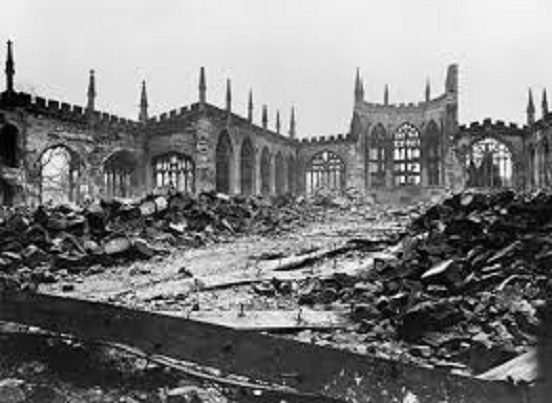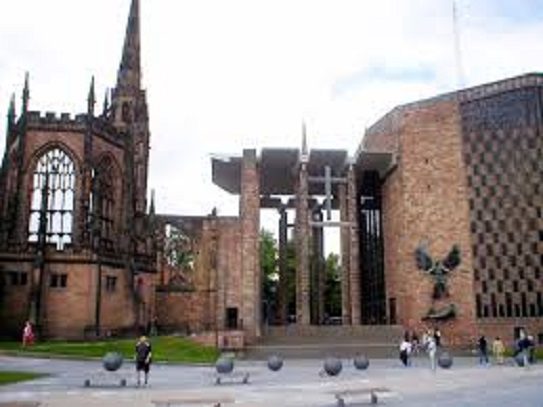In last Sunday’s gospel reading, Jesus tells us that those who wish to follow him should be prepared to “take up their cross.” In other words, those who follow Jesus can expect darkness, suffering, and pain to be part of the journey. In his homily, my friend and our rector Mitch made reference to the destruction of large parts of Coventry, England during a Nazi air raid in World War II; the destruction included Coventry’s centuries-old cathedral. I used the story of Coventry and its cathedral last January in a post just after Christmas. Here’s what I wrote:

Jesuit priest and author James Martin recently said in an interview that we as a culture have sanitized the Christmas story. During a conversation with a number of friends the other day I was reminded that the juxtaposition of promise and death, of expectation and suffering, is nothing new. This dissonance is built into the fabric of the stories that we tend to tell selectively and sanitize for public consumption at this time of year. The text of one of my favorite carols, the Coventry Carol, is a case in point. Its text is focused on yesterday’s gospel from Matthew, a story that you will definitely not see represented in anyone’s creche or on anyone’s front lawn.
The Coventry Carol is written in a minor key, appropriate for the shocking event that is its central concern. In Matthew’s gospel the early focus is not on the birth of Jesus (Luke’s more familiar story takes care of that), but on events occurring soon after. “Wise men from the East” have arrived in Jerusalem following a star that they believe portends the birth of a new king. After they refuse to take the current king Herod’s bait and choose to return home after visiting the Holy Family’s house (they’ve apparently moved out of the stable some time earlier) without revealing to Herod where the infant threat to his throne is living in Bethlehem, Herod orders the murder of all the male children under two years of age in Bethlehem. This is the theme of the Coventry Carol, so named because it is part of a cycle of 16th century songs that were performed in that city as a pageant dramatization of the birth narrative in Matthew.
Herod the king, in his raging,
Charged he hath this day.
His men of might, in his own sight,
All young children to slay.
Mary, Joseph, and Jesus escape the massacre because Joseph is tipped off by an angel of the danger. They escape to Egypt where the family stays until Herod dies. The Coventry Carol reminds us that even the Incarnation, the divine taking on human form, does not guarantee a respite from darkness, evil, and death. Indeed, this particularly horrible event—the massacre of innocent children—would not have even happened had it not been for the miraculous event of Jesus’ birth. Again and again we learn that goodness and evil abide together in a complex tangle that belies our hopes and dreams of a world in which all is goodness and light. Whatever is promised by the narrative of the Incarnation, it is not that.
The city of Coventry after which the carol is named was the location of yet another extraordinary mixture of hope and darkness during World War II. An industrial city in the West Midlands of England, Coventry was the target of numerous Luftwaffe bombing raids. The worst of these occurred on November 14, 1940; the devastation included the almost total destruction of Coventry’s gothic Saint Michael’s Cathedral that was built during the late 14th and early 15th centuries.
Various researchers revealed some decades later the likelihood that because the German secret “Enigma” code had just been broken by cryptographers at Bletchley Circle, British war authorities knew that Coventry had been targeted for a Luftwaffe fire-bombing raid some days before the raid occurred. These authorities chose not to alert the citizens of Coventry ahead of time because doing so would have revealed to the Germans that their supposedly unbreakable code had been cracked. Sir William Stephenson, the chief of all Allied intelligence during WWII, wrote that both Franklin Roosevelt and Winston Churchill were aware that Coventry was going to be bombed; Churchill reportedly told Stephenson after the war that letting Coventry burn aged him twenty years.
Others have challenged Stephenson’s story, but situations of overall good requiring destruction and death are disturbingly commonplace. A new Coventry Cathedral was built next to the ruins of the one destroyed in 1940, incorporating into its modern architecture the remains of the previous edifice as a testament to both hope and despair, triumph and sacrifice.

The theme of the dedication, and the continuing ministry of St. Michael’s Cathedral to this day, is reconciliation. Its art work, commissioned from all over the world, makes use of remnants of the old cathedral as well as materials not usually incorporated in religious art—the wreckage of automobiles, refuse from landfills—the last places we normally look for intimations of the sacred.
Paying attention to the Christian narrative reveals that the planners and parishioners of the cathedral in Coventry are on to something. When the divine enters the world, we may often look in vain for immediate evidence. Violence and suffering still occur, human beings continue to perpetuate atrocities on each other and on the world in which we live. The difference before God enters human reality and after is so subtle as to often be unnoticeable. But as a wise person once told me, this is not a God who intervenes. This is a God who indwells. In his lengthy Christmas poem “For the Time Being: A Christmas Oratorio,” W. H. Auden expresses this sentiment through Simeon, the old man who gets to see the infant Jesus just before he dies.
And because of His visitation, we may no longer desire God as if He were lacking: our redemption is no longer a question of pursuit but of surrender to Him who is always and everywhere present. Therefore, at every moment we pray that, following Him, we may depart from our anxiety into His peace.
Anxiety and fear are natural human responses to evil and suffering. But we do well to remember one of the promised names of the Messiah—Immanuel—means “God is with us.” We will look far and wide for reminders of Herod’s massacre of the Innocents in nativity sets in houses and front yards this Christmas season, but maybe such reminders should be there. They are just as much a part of the story as angels singing to shepherds.
In the darkest depths of despair, the promise is that God is with us, choosing to become part of the mess and transform it from within rather than impose solutions from the outside. As I heard someone say this morning, “we need to stop listening to fear and calling it wisdom.” At the heart of the beautiful and transformative story is, as Winston Churchill might have described it, “a mystery wrapped in an enigma.” The baby in a manger, as well as the dead babies in the streets of Bethlehem, call us to embrace hope when things are darkest. We are not alone.













